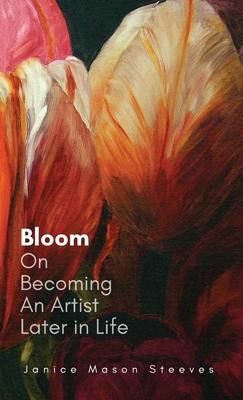
The pressures of the modern world force many into utilitarian careers early on. Artistic impulses lie unfulfilled, dormant. For some, at a certain point, there comes an ache in the bones, a deep longing for creative expression-a simultaneous sense of emptiness and overflowing feeling.
This was the case for the author, Janice Mason Steeves, who left a career in psychology to pursue art in her forties. She went back to school, graduated from the Ontario College of Art and Design, and went on to develop an international art career, an art consulting practice, and a highly sought after travel workshop business. Weaving together insights from her own art experience with the stories of 128 artists over the age of sixty, whom Janice surveyed for the book, Bloom offers guidance, inspiration, and support for the often difficult and misunderstood desire to change trajectory and take up a path of creativity and meaning.
Mason Steeves then takes these observations a step further, suggesting that not only is it possible to come to art later in life and be successful as an artist, but that the distillation of life experience and self-knowledge gleaned from the artist's path may enable older artists to step into an even larger role: that of a community elder. The elder role-acquired, in this case, through art but existing beyond art-is essential in our society, providing stability and depth, wisdom-keeping, space-holding, and care-taking, in Bill Plotkin's words, "for the very soul of the world."
The pressures of the modern world force many into utilitarian careers early on. Artistic impulses lie unfulfilled, dormant. For some, at a certain point, there comes an ache in the bones, a deep longing for creative expression-a simultaneous sense of emptiness and overflowing feeling.
This was the case for the author, Janice Mason Steeves, who left a career in psychology to pursue art in her forties. She went back to school, graduated from the Ontario College of Art and Design, and went on to develop an international art career, an art consulting practice, and a highly sought after travel workshop business. Weaving together insights from her own art experience with the stories of 128 artists over the age of sixty, whom Janice surveyed for the book, Bloom offers guidance, inspiration, and support for the often difficult and misunderstood desire to change trajectory and take up a path of creativity and meaning.
Mason Steeves then takes these observations a step further, suggesting that not only is it possible to come to art later in life and be successful as an artist, but that the distillation of life experience and self-knowledge gleaned from the artist's path may enable older artists to step into an even larger role: that of a community elder. The elder role-acquired, in this case, through art but existing beyond art-is essential in our society, providing stability and depth, wisdom-keeping, space-holding, and care-taking, in Bill Plotkin's words, "for the very soul of the world."
Hardcover
$27.99